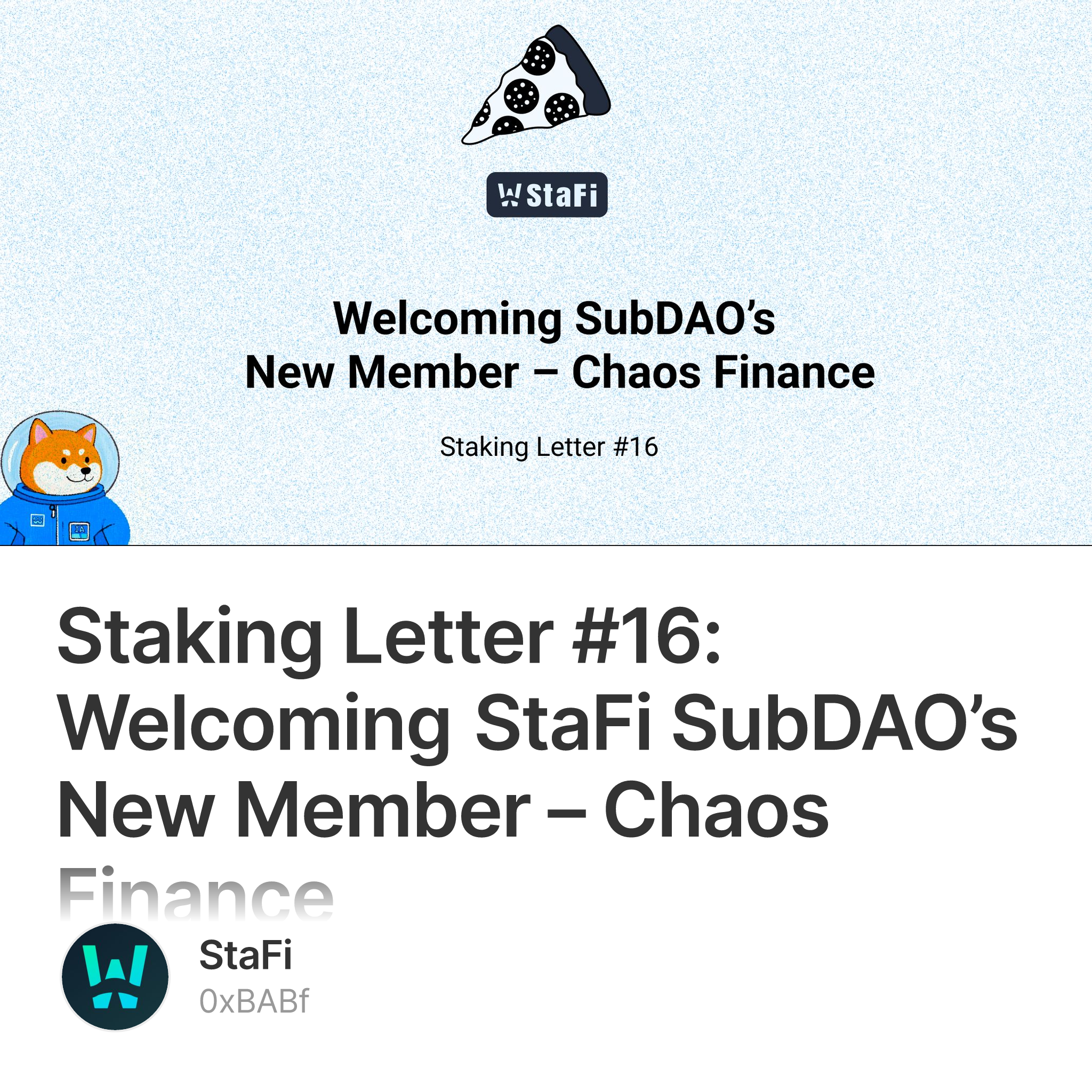StaFi introduced the SubDAO model as part of Revamp Wave #1, laying the foundation for a more modular and scalable liquid staking ecosystem. Each SubDAO functions as an independent Liquid Staking Token (LST) protocol with its own native token, empowering developers and communities to create customized staking solutions while maintaining StaFi’s ecosystem integrity.
To drive adoption and scalability, StaFi utilizes SubDAOs to launch new LST protocols through LSaaS (Liquid Staking as a Service). These SubDAOs not only foster innovation but also operate with independent tokens, allowing each entity to evolve based on its community’s specific needs while staying aligned with the broader StaFi network.
All SubDAO LST protocols are built on StaFi LSaaS’s comprehensive suite of tools and components, positioning them as flagship use cases for LSaaS. Meanwhile, LSaaS itself is set to receive major updates, with announcements coming soon.
Leading this transformation, Chaos Finance is the first SubDAO introduced under the StaFi Revamp Wave, marking the beginning of a new era for decentralized and scalable liquid staking solutions.
Introduction to Chaos Finance
Chaos Finance is a premier SONIC liquid staking protocol powered by StaFi AI LSaaS.
Sonic is the first atomic SVM (Solana Virtual Machine) chain designed to enable sovereign game economies on Solana.
It addresses a key challenge in blockchain gaming: running complex games with high performance while maintaining decentralization. As an atomic Solana Virtual Machine (SVM) chain, Sonic allows games to operate with their own economies while staying connected to Solana's security.
Chaos Finance transforms how SONIC token holders generate yield. While SONIC traditionally offers fixed staking options (3, 6, or 12-month lockups), staking through Chaos Finance provides sSONIC—an interest-bearing token with full liquidity within the SONIC ecosystem. sSONIC can be seamlessly integrated into various GameFi and DeFi applications, unlocking new yield opportunities across the SONIC SVM.
Chaos Finance Architecture
Chaos Finance is built on the Solana LSD Stack within StaFi’s AI-powered LSaaS.

Core Accounts:
-
StakeManager: Stores key sSONIC state information, including rate, stake details, and commission fees.
-
StakePool: Acts as an escrow account, managing funds between stakers and the Sonic staking program.
-
UnstakeAccount: Records unstake details such as recipient, amount, and withdrawal index.
Core Roles:
- Admin: Oversees and manages sSONIC network parameters.
How to Get Involved
Required Wallet
To participate, install a compatible wallet. This guide uses Backpack as an example, but other wallets function similarly:
Access the Staking Page
Visit the SONIC Staking App and click “Connect Wallet.”

Connect Your Wallet
Click “Connect” to link your wallet to the staking platform.

Enter Staking Amount
Specify the amount of SONIC you want to stake. Review the corresponding sSONIC you will receive and the Annual Percentage Rate (APR). Click “Stake” to proceed.

Confirm Transaction
Upon clicking “Stake,” your Backpack wallet will prompt you to review the transaction details, including gas fees. Click “Confirm” to sign the transaction. Wait for confirmation and successful completion of the staking operation.

With the introduction of Chaos Finance, StaFi’s SubDAO model continues to drive the evolution of decentralized liquid staking solutions, expanding opportunities for users across the SONIC ecosystem. Stay tuned for further updates on LSaaS and the next wave of innovations!
About StaFi
StaFi is a leading Liquid Staking infrastructure provider and protocol for PoS chains. Its Liquid Staking as a Service (LSaaS) framework enables developers to create Liquid Staking Tokens (LSTs) and Liquid Re-staking Tokens (LRTs) across ecosystems like ETH, EVM, BTC, CosmWasm, and SOL. By issuing rTokens (e.g., rETH, rMATIC, rBNB), StaFi unlocks the liquidity of staked assets, allowing users to earn staking rewards while retaining the flexibility to engage in DeFi. With support for major blockchains such as Ethereum, Solana, Polygon, BNB Chain, and Cosmos, StaFi bridges liquidity and security in Proof-of-Stake networks.
Read more about StaFi 2.0.
About LSaaS
LSaaS is a paradigm shift offering developers a robust framework to build their own Liquid Staking Tokens (LSTs) and Liquid Re-staking Tokens (LRTs). Compared to Rollup as a Service(RaaS), RaaS projects, like Altlayer, Dymension and Conduit, are primarily concerned with improving blockchain scalability and efficiency through layer 2 solutions.
For a deeper comparison and analysis, you can check out the full article: Read here.

